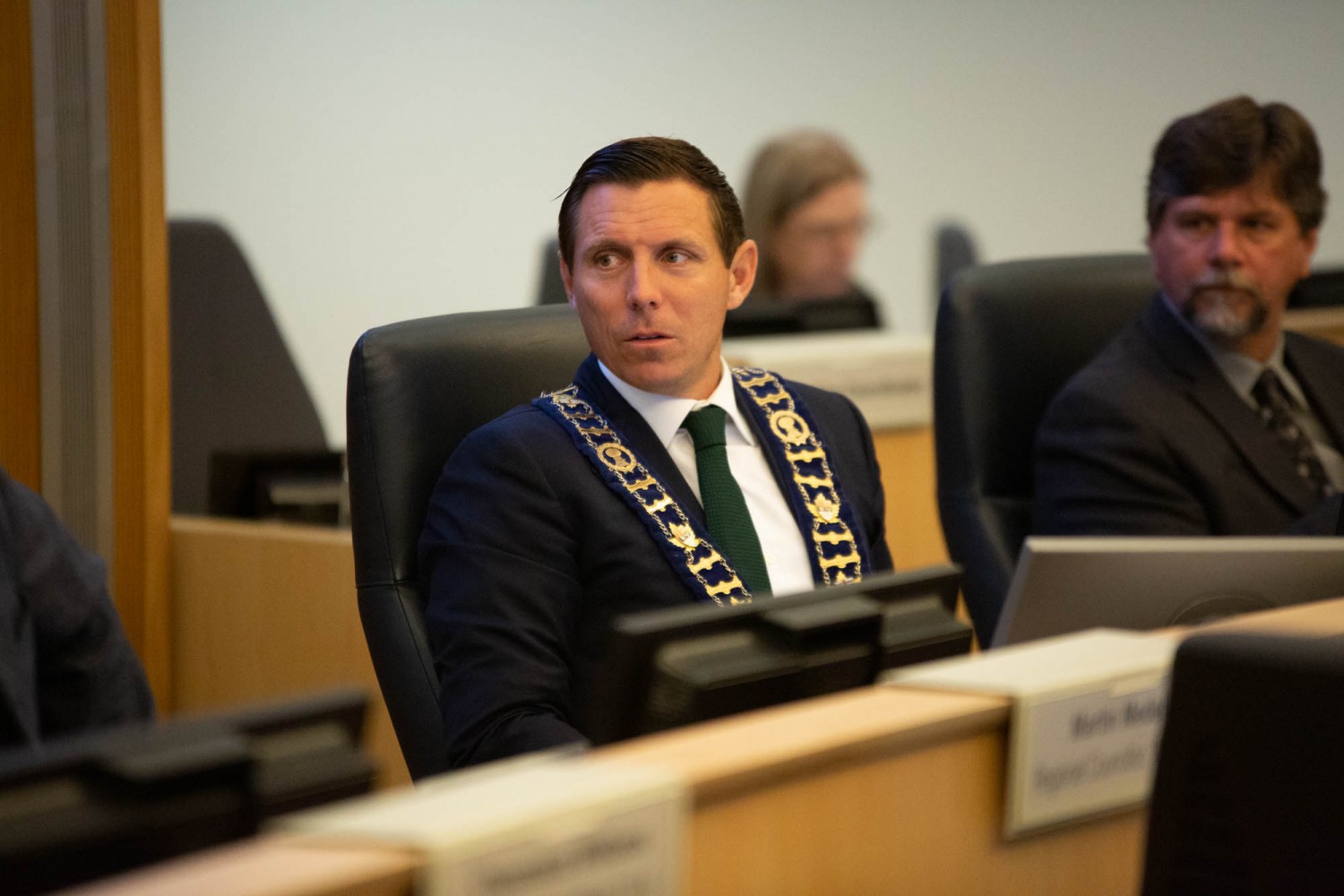
Brown misleads public on Province’s 413 Highway planned for Brampton’s west side
Campaigning is easy — your promises only count if you win.
As leader of the Progressive Conservatives before he was forced to step down in 2018, Patrick Brown pledged to resurrect the GTA West Corridor, also known as Highway 413. “When I was the opposition leader at Queen’s Park, I put [the highway] in the platform. I personally put it in the platform,” he told The Pointer in 2019.
The project was scrapped months before the election by the Liberal government after an expert panel found it would be an environmental disaster and bring no cure to the region’s chronic issues with congestion. After a crushing victory that demolished the Liberal mandate, Brown’s replacement, Doug Ford, promptly put the highway back on the legislative agenda.
He had made clear during the campaign that the wishes of powerful developers, to build in and around Ontario’s protected Greenbelt, would be granted, even if it meant encroaching on ecologically sensitive lands.
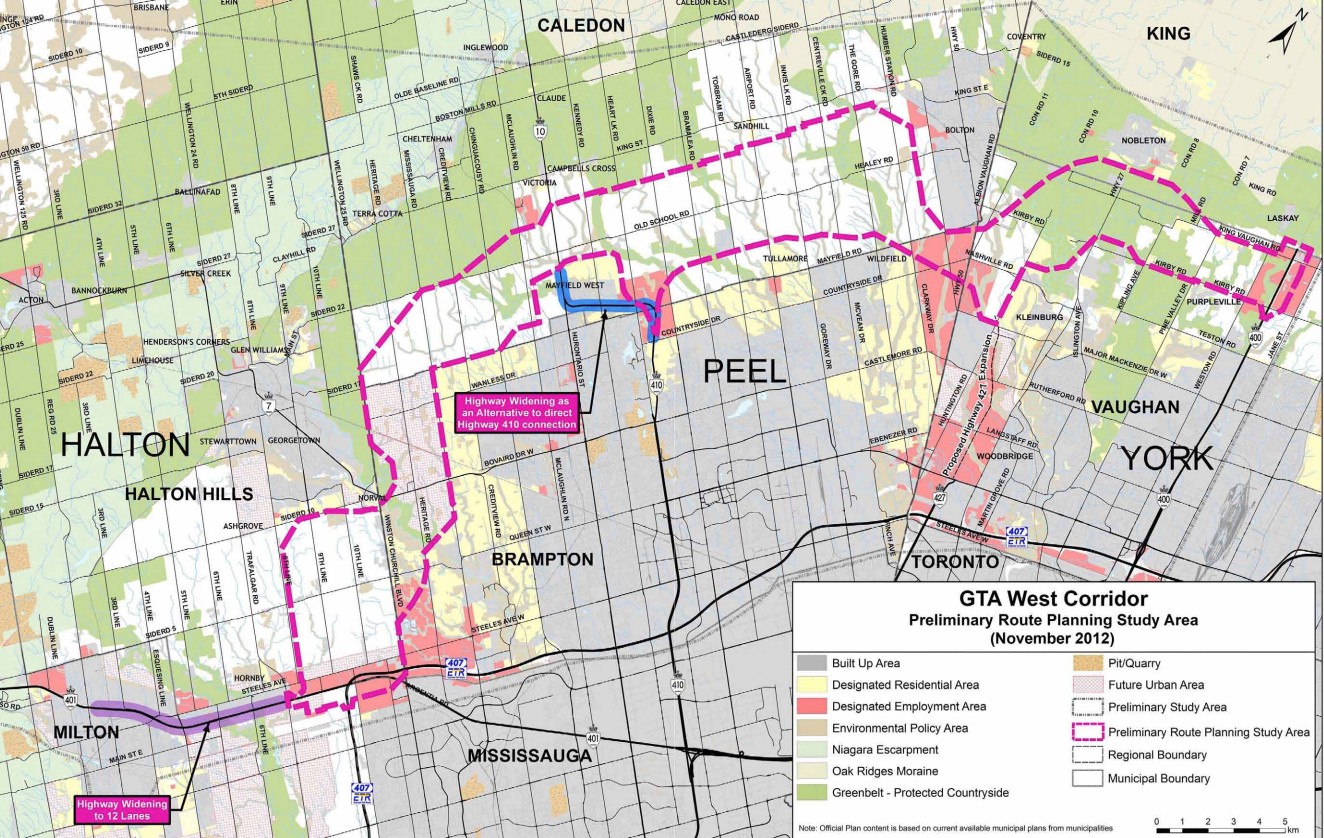
The GTA West Highway's proximity to the Greenbelt could have devastating impacts on the environmentally sensitive lands.
The GTA West Highway is the key to unlocking billions of dollars for the builders who have assembled lands right along the corridor where the 413 is now set to be built.
After falling from grace and out of favour with the party that quickly turned its back on him, Brown picked himself up and launched his surprising campaign to become mayor of Brampton. He promised residents the opposite of his pro-developer stance at Queen’s Park. He told voters the City’s recently completed 2040 Vision, formulated with input from thousands of local residents desperate to reshape Brampton’s future, their aspirations for a more livable, modern city, were his as well. He threw himself behind the plan that imagined a dense, dynamic, active community – nothing like the vast expanse of sprawl built by developers who had created the city’s isolating suburban identity after decades of unchallenged influence.
Brown won and residents waited eagerly for him to deliver his campaign promises, to reshape a city whose form had been badly damaged.
But Brown the politician has proven to be quite different from Brown the visionary.

After Brown's election victory in 2018, he promised change for Brampton.
The turmoil of his competing claims — simultaneously supporting smart growth and a highway, traditional suburbanites and modern progressives — is now playing out inside City Hall. Brown and some who follow him on Council support a made-in-Brampton vision for the transportation corridor that will dictate the largest accommodation of massive growth over the next three decades. They also refuse to accept it is incompatible with the Province’s plan.
Its GTA West corridor and the sprawling single-family homes it will spawn is the desire of the subdivision developers.
A plan to create “Heritage Heights”, something entirely different, on the last undeveloped tracts in Brampton, is the dream of the 2040 Vision. The modern community concept, with complete streets, active transportation and a boulevard instead of a highway, is incompatible with the 413 design.
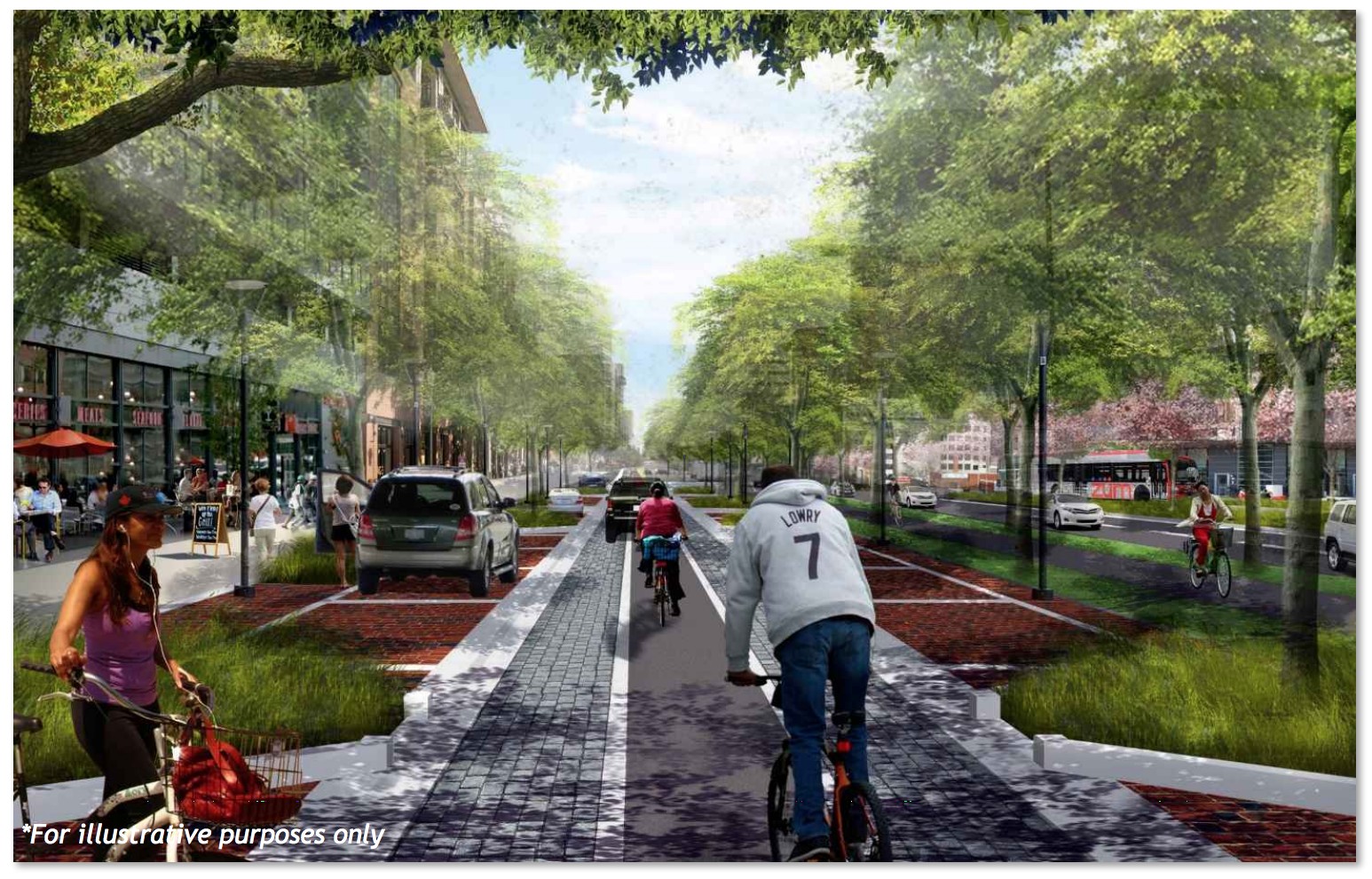
The City of Brampton's vision for Heritage Heights; a dense, walkable community.
In 2019, Council endorsed the GTA West Highway. A year later, the City publicly announced its boulevard concept for Heritage Heights along the highway’s route. Brown and some members around the council table will not admit the two plans simply can’t work together.
The Pointer approached every Brampton councillor and Mayor Brown to ask, since the GTA West Highway and a boulevard through Heritage Heights are incompatible, which project they support. Only Martin Medeiros, Harkirat Singh, Doug Whillans and Brown responded.
Of the four, Whillans is the only councillor who took a firm stance. “I support the Boulevard and I am opposed to the Brampton portion of a Highway,” he responded.
Mayor Brown stubbornly maintained that he does not “see any contradiction” between the City’s boulevard proposal and “support for GTA West Corridor,” before referencing disproven travel-time benefits of the highway and mentioning “gridlock in Peel”.
He then misrepresented the Province’s position on the City’s proposed boulevard design. The Pointer shared with him the response received in August from the Ministry of Transportation, which stated the boulevard is not compatible with its intended design for the highway.
“Our preliminary review of the proposal put forward suggests that the proposed roadway design is not compatible with the Province’s functional and operational objective for the GTA West corridor,” a spokesperson said last month. “The corridor must meet Provincial standards for design and operating speed, access, interchange design and separation, and other 400-series highway geometrics in order to provide for Provincial transportation needs.”
Confronted with the statement Tuesday, Brown said he has received a different response from Queen’s Park. “The response we have had from the province is much more encouraging than the response you received,” he told The Pointer. “We will continue our advocacy for the Boulevard option,” he said. “MPP [Prabmeet] Sarkaria and MPP [Amarjot] Sandhu, who are members of the government caucus, are helping the City with our advocacy as well. I spoke to the Minister Mulroney’s office and they were very open to our proposal as well.”
The Pointer shared Brown’s claim with the Ministry of Transportation Tuesday. Its senior issues advisor, Michael O’Morrow, replied in an email, “Our previous statement from August regarding the Heritage Heights proposal still stands.”
Communications staff for the City of Brampton were unable to verify if the City had received positive signs from the Province. A spokesperson said Brown “can speak to conversations he’s had with provincial staff or elected officials.”
Brown insists he can support the sprawl-inducing highway and a completely different concept, for a boulevard at the centre of a much denser, modern, complete community under the Heritage Heights plan.
The City itself recognizes what Brown doesn’t, that the two are incompatible.
“The Heritage Heights concept plan, recently endorsed by Council, delivers a ‘complete communities’ model and is a better direction for all stakeholders,” the City of Brampton told The Pointer in August, shortly after the PC government approved the route for the 413 Highway, right through the planned Heritage Heights area.
“The GTA West Corridor project, first launched in 2005, reflects a conventional transportation approach that has typically resulted in urban sprawl and contributes to additional congestion… The proposed Urban Motorway represents more than three times the development potential and job creation than would exist with a 400 series highway bisecting the area. The concept plan endorsed by Council is more successful at maximizing value creation and contributes to a more sustainable financial position for the city, region and province.”
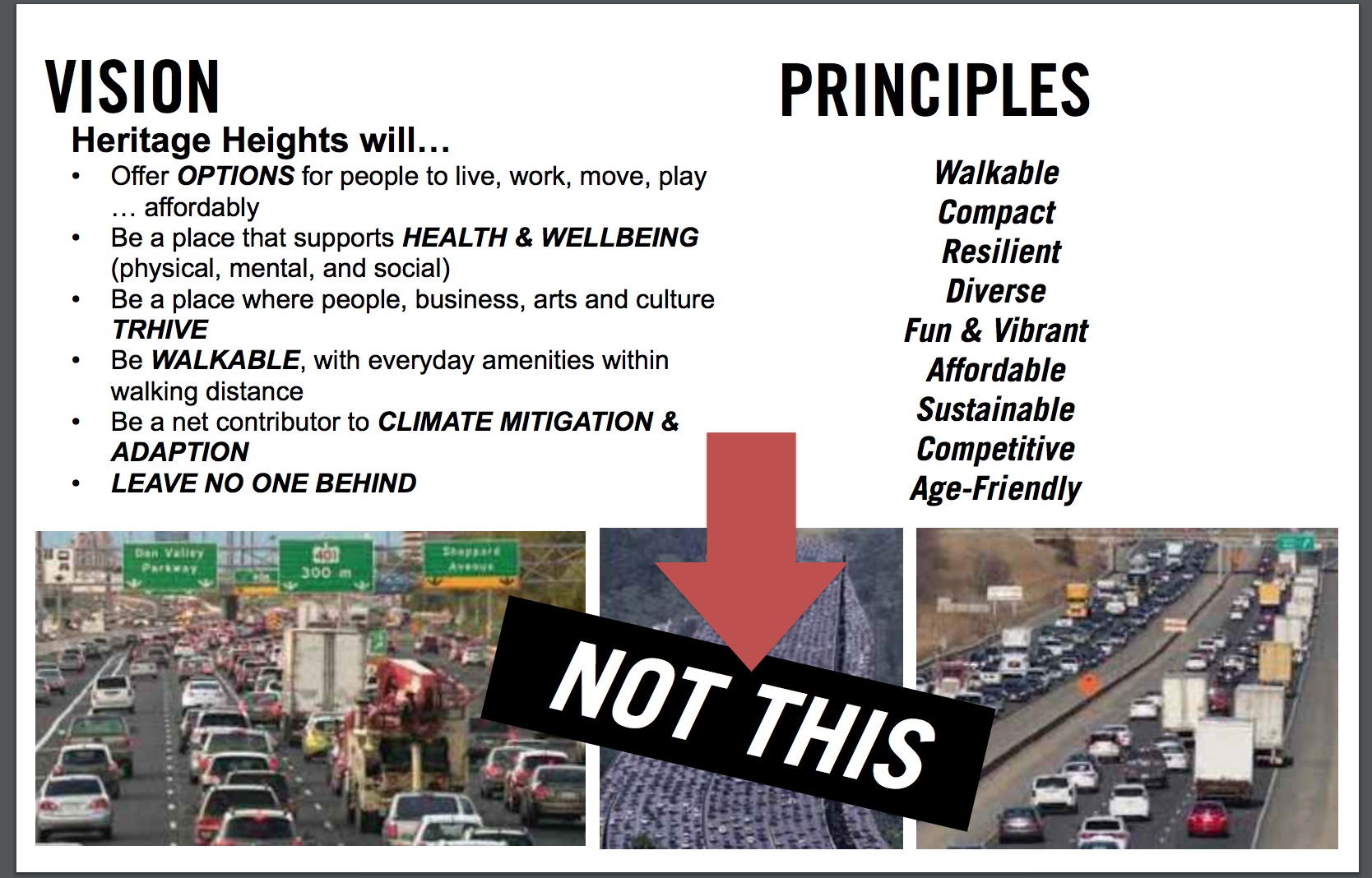
A slide from the City of Brampton's presentation on Heritage Heights, which shows a desire to move away from mega highways like the GTA West Highway. Mayor Brown tells The Pointer he believes the two plans are compatible.
The City’s position calls Brown’s original decision, when he was the PC Leader of Ontario and put the 413 Highway on his party’s election platform, before he had to step down, bad transportation planning that leads to “urban sprawl” and “additional congestion”.
Brown, meanwhile, is still claiming the highway will improve congestion, and the Province refutes his claim that it has said anything supportive of the City’s boulevard proposal.
His support for the GTA West Highway within Brampton began in June 2019, when City Council endorsed a move at Queen’s Park by the PCs to restart an Environmental Assessment on the previously scrapped highway. In total, five councillors spoke in support of the endorsement and none opposed it. Within the same meeting, the City unanimously declared a climate emergency with no one around the council table noticing the irony.
“This initiative by a government MPP likely means the government supports it and we should certainly give credit where credit is due. This would be a win for GTA West Corridor,” Brown told council at the time. Medeiros, chair of the Planning and Development Committee, said the project was “long overdue.”
Michael Palleschi, who tabled the motion in support of the project, spoke at length about the apparent benefits it would bring to Brampton, especially in terms of employment. Councillors Singh and Gurpreet Dhillon both verbally expressed their support as well. The motion passed unanimously.
The degree to which developers have controlled the City’s own Heritage Heights growth plan is alarming.
The City, inexplicably, entered into an agreement with the developers who bought the land around the proposed highway area in Heritage Heights. Under former mayor Susan Fennell, in 2013, developers were given control over any “plans, studies or reports” regarding the future growth of the area, and no such work could proceed without the consent of the developers.
This is extremely uncommon, as municipalities are expected to decide what studies and plans they themselves undertake to determine the growth of their own communities.
Developers gave the City almost $2.4 million to do any work to determine the future planning of Heritage Heights and the funds could only be used with their approval.
Illustrating the extent to which they demanded support not only for the construction of the GTA West Highway, but where it would have to be built, to maximize their profit, the developers stated the City could not explore any routing for the highway that was not where their land was located.
City staff wrote the following in a previous report to the former council, updating the progress on the Heritage Heights plan: “On December 22, 2017, staff received a separate letter… representing the Heritage Heights Landowners Group, indicating that they do not support any work in connection to the GTA West road alignment west of Heritage Road. Staff do not have any objection to this statement and will not be pursuing this option.”
The control of the process by developers at the municipal level raises questions about the City’s own 2040 Vision, the master plan for future growth that calls for dense, compact communities, a hub concept instead of sprawl, and gave rise to the boulevard design, not the highway supported by developers, which would greatly elevate the value of the land they have already assembled to build homes on.
Is the City controlling its own growth, or are the developers?
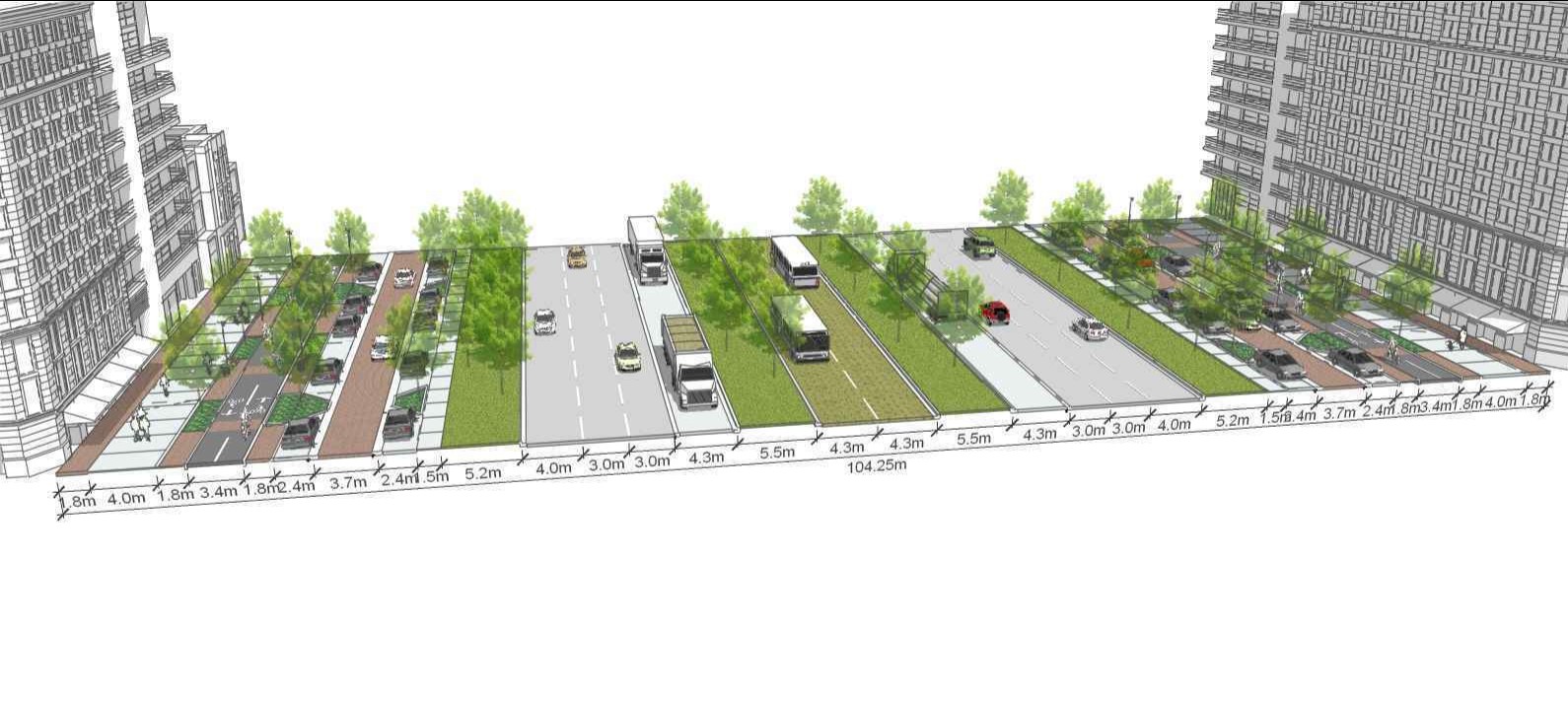
It's unclear how a 400-series highway could be run through the city's proposed boulevard design.
For almost 40 years, Brampton’s planning was dictated by builders, resulting in sprawl and a terrible financial position for the City, which can’t raise adequate property taxes because single-family homes are spread out and each unit per hectare only provides a fraction of tax revenue compared to the number of units that would contribute in a much more dense model. The cost to build and maintain infrastructure for sprawl is also crippling.
In its response to The Pointer, criticizing the highway approach being pushed by the developers, the City stated the boulevard approach and its complete community concept “is more successful at maximizing value creation and contributes to a more sustainable financial position for the city, region and province.”
Heritage Heights, staff say, could be built around a boulevard instead of a 400-series highway, with a priority lane for buses, one for trucks and a local streets network on the edges of a faster portion of road. During a May council workshop and later at a July Planning and Development meeting, staff said a new highway would bring sprawl and congestion. They said their boulevard concept represented better future planning.
Council embraced the idea wholeheartedly, asking for a recorded vote simply so each councillor could have their sentiments on the record. “Let’s end the sprawl,” Councillor Paul Vicente said as he cast his vote in support of the plan.
But no one addressed the elephant in the room: you can’t have a highway and a boulevard running on the same stretch. The idea of slowing a highway down to run as a boulevard for a certain distance has not yet been addressed by the City or council and has been rejected by the province.
If it were possible to turn a 400-series highway into a boulevard and back again, the onus would be on the City to prove that and not the Province.
Despite this — and the enthusiastic support they have thrown behind the Heritage Heights proposal — no one on council has denounced the proposed Highway 413, other than Whillans. The Province, responsible for building the new highway, says the boulevard doesn’t fit its plan.
It is unclear how Brampton intends to proceed from here, unwilling to condemn the provincial project and hopeful of getting a dense, modern community with a modern boulevard.
Supporters of the GTA West, including Mayor Brown and his Caledon counterpart Allan Thompson, argue the highway is necessary to alleviate congestion. The findings of the 2018 expert panel, which effectively killed the project under the Liberals, discovered this wasn’t the case at all.
“The GTAW Recommended Actions would deliver approximately one minute of travel time savings per vehicular trip across the Greater Golden Horseshoe,” the panel observed in 2018. But even that one minute will only come if other highway expansions and modifications (many of which are already underway) are realized. According to the panel, just 30 seconds will be saved as a direct result of the proposed GTA West Highway.
The panel also found that “additional highways can induce significant suburban expansion,” the very opposite of the Heritage Heights plan councillors say they support.
Both Palleschi and Brown have also conflated the highway with employment opportunities. “One of the challenges we have in Brampton is gridlock; the ability to get product to marketplace is critical. Every time we look at economic development, it is a critical component of our pitch,” Brown said in June 2019.
Palleschi linked neighbouring Mississauga’s superior job market to its network of 400-series provincial highways. “You look at some of the highways Mississauga has, and what is around the majority of those highways is great employment opportunities. What’s Brampton lacking? Employment opportunities,” he said.
The City’s own position is that the boulevard plan “represents more than three times the development potential and job creation than would exist with a 400 series highway bisecting the area.”
The provincial panel of experts cast doubt on the assertion used by Palleschi as well. “Freight distribution patterns are shifting,” they wrote, noting that “employment is becoming more flexible, as it moves away from manufacturing and towards the service sector.” The current shift away from commuting to work, which employment experts around the world say will be a permanent fixture of the new job market long after the pandemic, also raises questions about the need for the 413. Critics also doubt who it would benefit, as commuters in Brampton likely would not use it unless they travel from the city’s west side toward Milton, or go north and east toward Vaughan. It offers no benefit for those travelling into central Mississauga, Toronto or other parts of the GTA south of the 407 toll highway.
The Province has not determined whether the 413, if it’s built, will also be a toll route.
Something else Palleschi did not allude to is the quality of jobs Mississauga attracts, with pharmaceutical and airline industries especially taken with the city. Those high-skilled jobs rely on good travel connections, increasingly rail and other modes of transit, not congestion-creating highways, to attract new companies. For years, Brampton has struggled to tempt a more diverse marketplace, lumbered instead with logistics and trucking companies, warehouses and fulfillment centres, which provide few jobs or tax revenues per-hectare, but would indeed see the appeal of a new highway. Is this what Brampton wants to attract, low-wage, low-skilled jobs for one of the most educated workforces in the country?
Generational shifts too mean a reliance on the car to get to and from far-flung jobs in suburbia may not last. “As baby boomers age and retire, their travel needs and patterns will change. Millennials are already displaying different travel patterns than previous generations,” the expert panel report, which advised the scrapping of the highway plan, states.
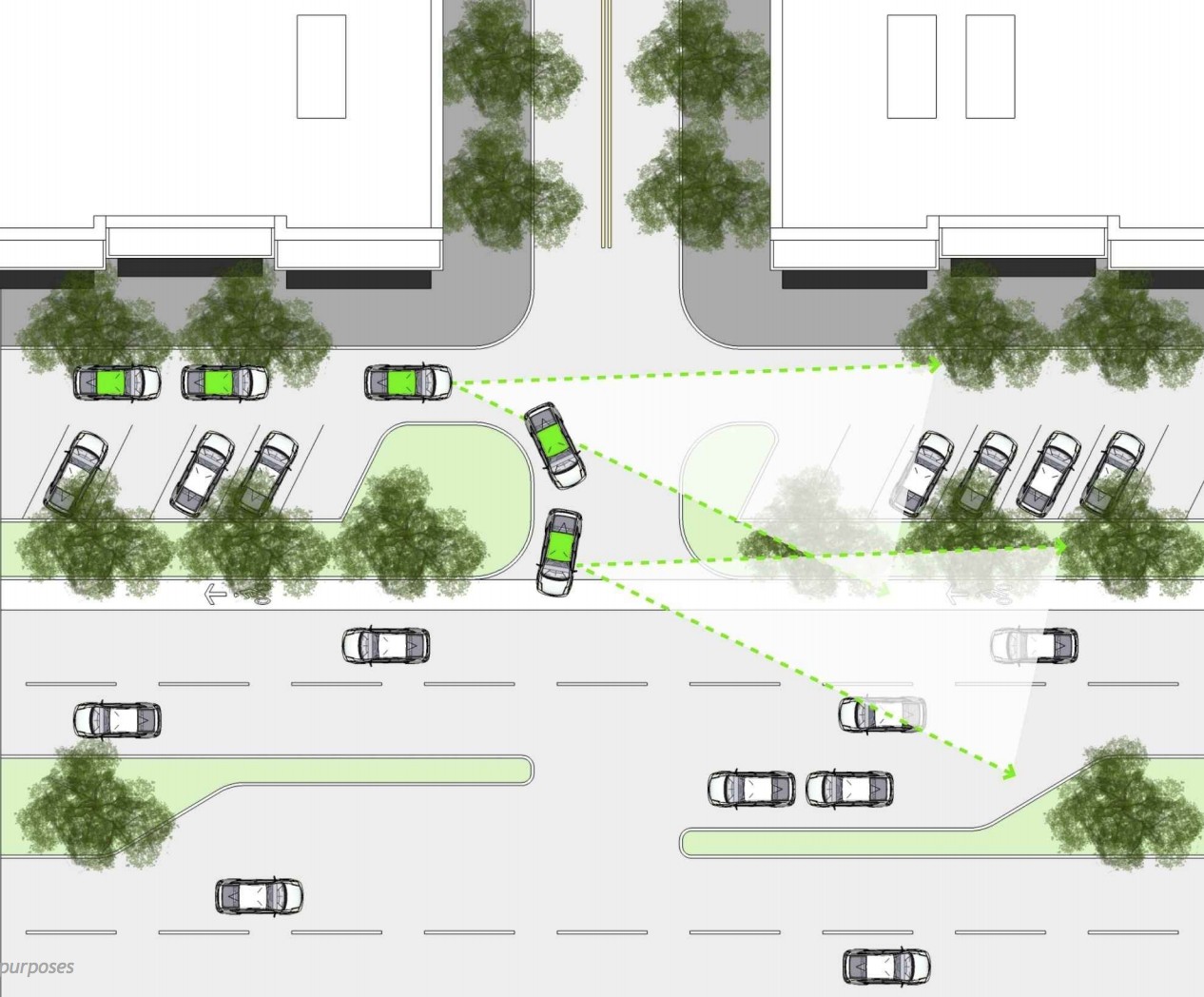
If the GTA West Highway is to run through Heritage Heights, it's unclear how drivers would merge from the boulevard onto the highway without on-ramps.
On October 8, the Brampton mayor and several councillors will rub virtual shoulders with a plethora of influential and progressive planners. Brown will introduce an event co-hosted by the Urban Land Institute (ULI) Toronto, City of Brampton, City of Helsinki, Greenberg Consultants and University of Toronto School of Cities considering the potential of modern, smart growth projects in Brampton.
The event boasts Anni Sinnemäki, Deputy Mayor of Urban Environment for the City of Helsinki, Matti Siemiatycki, Interim Director at University of Toronto School of Cities and planner Ken Greenberg. The virtual town hall will bring together professional planners, academics and city officials to discuss the sustainable future of Brampton.
It’s a group that does not support highways as the answer for future transportation planning.
Despite spending next Thursday among progressive planning royalty, the mayor and his councillors are unable to roundly dismiss a project that threatens the dense future they purport to want for Heritage Heights and the rest of Brampton as it is projected to swell to almost a million residents.
If Council is unable to unite against the highway, it seems unlikely Queen’s Park will take the City’s plans for Heritage Heights seriously. In turn, voters will also wonder which promises Brown intends to keep and whose interests he’s working for.
Email: [email protected]
Twitter: @isaaccallan
Tel: 647 561-4879
COVID-19 is impacting all Canadians. At a time when vital public information is needed by everyone, The Pointer has taken down our paywall on all stories relating to the pandemic and those of public interest to ensure every resident of Brampton and Mississauga has access to the facts. For those who are able, we encourage you to consider a subscription. This will help us report on important public interest issues the community needs to know about now more than ever. You can register for a 30-day free trial HERE. Thereafter, The Pointer will charge $10 a month and you can cancel any time right on the website. Thank you.
Submit a correction about this story


